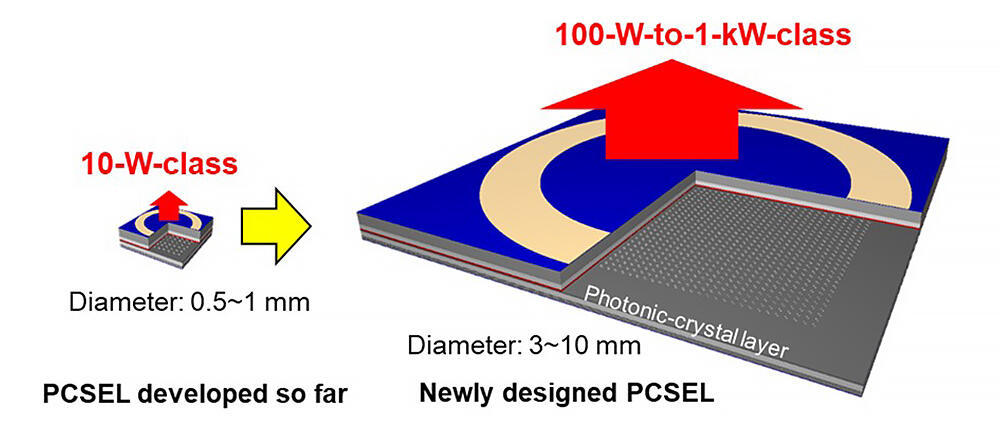When the area of a semiconductor laser is increased to achieve higher output power, the beam quality degrades due to multiple-mode lasing, making it impossible to focus the beam. For example, the use of conventional semiconductor lasers in LiDAR sensing (optical ranging system) for automobiles requires a complex lens system and precise optical alignment, which makes the system expensive. Moreover, the brightness, defined as optical power per unit area per unit solid angle, of conventional semiconductor lasers is insufficient for laser processing. The PCSEL is regarded as the only laser which can solve these fundamental issues. Compact LiDAR systems have been already constructed by using 10W-class PCSELs. A group consisting of Professor Susumu Noda, Assistant Professor Takuya Inoue, Assistant Professor Masahiro Yoshida, and Program-Specific Researcher John Gelleta of the Graduate School of Engineering at Kyoto University, has established design principles to realize photonic-crystal surface-emitting lasers (PCSELs) capable of single-mode 100W to 1kW operation over very large areas of 3 to 10 mm in diameter. "Based on this theory, we hope to develop 3-mm-diameter PCSELs and demonstrate 50-to-100-watt continuous wave operation within a year," explains Professor Noda. "We will be able to achieve direct laser processing at a level that can cut metal with PCSELs." The group's findings were published in Nature Communications on July 4, 2022.

Provided by Kyoto University
Currently, large, expensive, and low-efficiency light sources such as gas, solid, and fiber lasers are used for high-power laser applications such as metal cutting. The cost and size of these light sources can be significantly reduced if they can be replaced with a semiconductor laser.
To solve the fundamental issues of semiconductor lasers, the research group has been developing PCSELs, which enable large-area, single-mode lasing by controlling the mutual coupling of light waves propagating inside the photonic crystal layer. They proposed a resonator called a double-lattice photonic crystal structure, in which two holes are shifted by one-quarter wavelength in the X and Y directions. By cutting off higher-order modes they successfully produced high-quality laser oscillation in a single, fundamental mode. The group already demonstrated 10-watt-class operation with PCSELs ranging from 0.5 to 1 mm in diameter. The group also succeeded in developing a LiDAR equipped with PCSELs. According to Professor Noda, "After we announced this, we received inquiries from about 74 companies from around the world for joint research and practical use of this technology."
Although it is possible to use PCSELs for marking of metal surfaces with their current output powers of ~10 watts under continuous wave conditions, higher powers are needed for metal cutting. Therefore, the research group has theoretically identified the general conditions for stable single modes in ultra-large-area PCSELs with diameters of 3 to 10 mm. When the diameter of previously designed PCSELs exceeded 2 mm, the PCSELs began to operate not only in the fundamental mode, from which light is emitted vertically, but also in higher-order modes, from which light is emitted at tilted angles. To suppress the higher-order mode emission at tilted angles, they have adjusted the spacing between the two paired holes and the size and ellipticity of each hole, and have optimized the distance of the reflector attached to the backside of the photonic crystal layer. In this way, they established a new design that is capable of single-mode laser oscillation even with a diameter of 3 to 10 mm.
Once 100-watt to even 1kW class lasing is realized based on this theory, many of today's high-power lasers will likely be replaced by PCSELs. As the first step towards this goal, they aim to achieve 50- to 100-Watt-class cw lasing within a year.
* This work was carried out under the project of Council for Science, Technology and Innovation (CSTI), Cross ministerial Strategic Innovation Promotion Program (SIP), "Photonics and Quantum Technology for Society 5.0" (Funding agency: QST).
Journal Information
Publication: Nature Communications
Title: General recipe to realize photonic-crystal surface-emitting lasers with 100-W-to-1-kW single-mode operation
DOI: https://www.nature.com/articles/s41467-022-30910-7
This article has been translated by JST with permission from The Science News Ltd.(https://sci-news.co.jp/). Unauthorized reproduction of the article and photographs is prohibited.




